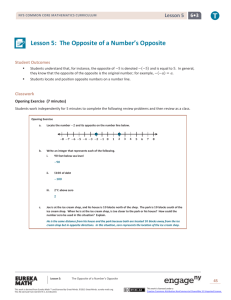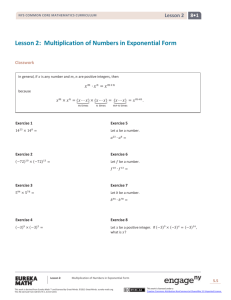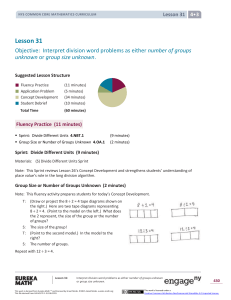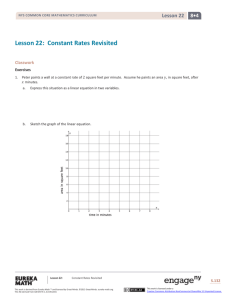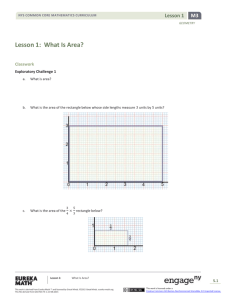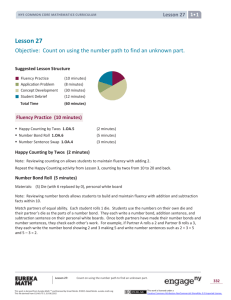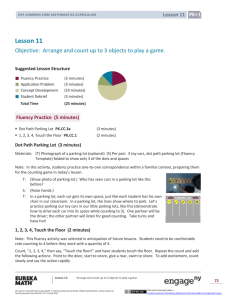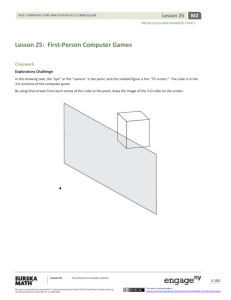Lesson 12 - EngageNY
advertisement
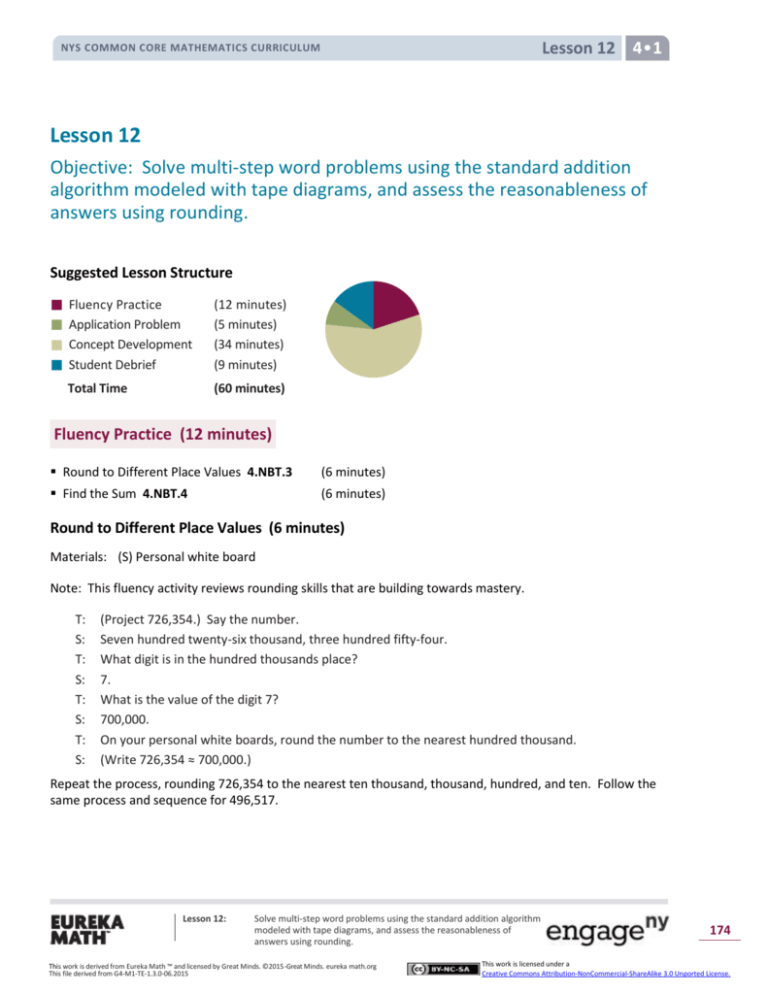
Lesson 12 NYS COMMON CORE MATHEMATICS CURRICULUM Lesson 12 Objective: Solve multi-step word problems using the standard addition algorithm modeled with tape diagrams, and assess the reasonableness of answers using rounding. Suggested Lesson Structure Fluency Practice Application Problem Concept Development Student Debrief Total Time (12 minutes) (5 minutes) (34 minutes) (9 minutes) (60 minutes) Fluency Practice (12 minutes) Round to Different Place Values 4.NBT.3 (6 minutes) Find the Sum 4.NBT.4 (6 minutes) Round to Different Place Values (6 minutes) Materials: (S) Personal white board Note: This fluency activity reviews rounding skills that are building towards mastery. T: S: T: S: T: S: T: S: (Project 726,354.) Say the number. Seven hundred twenty-six thousand, three hundred fifty-four. What digit is in the hundred thousands place? 7. What is the value of the digit 7? 700,000. On your personal white boards, round the number to the nearest hundred thousand. (Write 726,354 ≈ 700,000.) Repeat the process, rounding 726,354 to the nearest ten thousand, thousand, hundred, and ten. Follow the same process and sequence for 496,517. Lesson 12: Solve multi-step word problems using the standard addition algorithm modeled with tape diagrams, and assess the reasonableness of answers using rounding. This work is derived from Eureka Math ™ and licensed by Great Minds. ©2015 -Great Minds. eureka math.org This file derived from G4-M1-TE-1.3.0-06.2015 174 This work is licensed under a Creative Commons Attribution-NonCommercial-ShareAlike 3.0 Unported License. Lesson 12 NYS COMMON CORE MATHEMATICS CURRICULUM Find the Sum (6 minutes) Materials: (S) Personal white board Note: This fluency activity prepares students for understanding the importance of the algorithm. T: S: (Write 417 + 232 =____.) Solve by writing horizontally or vertically. (Write 417 + 232 = 649.) Repeat the process and sequence for 7,073 + 2,312; 13,705 + 4,412; 3,949 + 451; 538 + 385 + 853; and 23,944 + 6,056 + 159,368. Application Problem (5 minutes) The basketball team raised a total of $154,694 in September and $29,987 more in October than in September. How much money did they raise in October? Draw a tape diagram, and write your answer in a complete sentence. NOTES ON MULTIPLE MEANS OF REPRESENTATION: Students working below grade level may have difficulty conceptualizing word problems. Use smaller numbers or familiar contexts for problems. Have students make sense of the problem, and direct them through the process of creating a tape diagram. “The pizza shop sold five pepperoni pizzas on Friday. They sold ten more sausage pizzas than pepperoni pizzas. How many pizzas did they sell?” Have a discussion about the two unknowns in the problem and about which unknown needs to be solved first. Students may draw a picture to help them solve. Then, relate the problem to that with bigger numbers and numbers that involve regrouping. Relay the message that it is the same process. The difference is that the numbers are bigger. Note: This is a comparative word problem that reviews the addition algorithm practiced in the last lesson. Concept Development (34 minutes) Materials: (S) Personal white board Problem 1: Solve a multi-step word problem using a tape diagram. The city flower shop sold 14,594 pink roses on Valentine’s Day. They sold 7,857 more red roses than pink roses. How many pink and red roses did the city flower shop sell altogether on Valentine’s Day? Use a tape diagram to show the work. Lesson 12: Solve multi-step word problems using the standard addition algorithm modeled with tape diagrams, and assess the reasonableness of answers using rounding. This work is derived from Eureka Math ™ and licensed by Great Minds. ©2015 -Great Minds. eureka math.org This file derived from G4-M1-TE-1.3.0-06.2015 175 This work is licensed under a Creative Commons Attribution-NonCommercial-ShareAlike 3.0 Unported License. Lesson 12 NYS COMMON CORE MATHEMATICS CURRICULUM T: S: T: S: T: T: S: T: MP.2 T: S: T: S: T: S: T: S: T: S: Read the problem with me. What information do we know? We know they sold 14,594 pink roses. To model this, let’s draw one tape to represent the pink roses. Do we know how many red roses were sold? No, but we know that there were 7,857 more red roses sold than pink roses. A second tape can represent the number of red roses sold. (Model on the tape diagram.) What is the problem asking us to find? The total number of roses. We can draw a bracket to the side of both tapes. Let’s label it R for pink and red roses. First, solve to find how many red roses were sold. (Solve 14,594 + 7,857 = 22,451.) What does the bottom tape represent? The bottom tape represents the number of red roses, 22,451. (Bracket and label 22,451 to show the total number of red roses.) Now, we need to find the total number of roses sold. How do we solve for R? Add the totals for both tapes together. 14,594 + 22,451 = R. Solve with me. What does R equal? R equals 37,045. (Write R = 37,045.) Let’s write a statement of the answer. (Write: The city flower shop sold 37,045 pink and red roses on Valentine’s Day.) Problem 2: Solve a two-step word problem using a tape diagram, and assess the reasonableness of the answer. On Saturday, 32,736 more bus tickets were sold than on Sunday. On Sunday, only 17,295 tickets were sold. How many people bought bus tickets over the weekend? Use a tape diagram to show the work. T: S: Tell your partner what information we know. We know how many people bought bus tickets on Sunday, 17,295. We also know how many more people bought tickets on Saturday. But we do not know the total number of people that bought tickets on Saturday. Lesson 12: Solve multi-step word problems using the standard addition algorithm modeled with tape diagrams, and assess the reasonableness of answers using rounding. This work is derived from Eureka Math ™ and licensed by Great Minds. ©2015 -Great Minds. eureka math.org This file derived from G4-M1-TE-1.3.0-06.2015 176 This work is licensed under a Creative Commons Attribution-NonCommercial-ShareAlike 3.0 Unported License. Lesson 12 NYS COMMON CORE MATHEMATICS CURRICULUM T: S: T: S: T: T: S: T: S: S: T: T: S: T: T: S: Let’s draw a tape for Sunday’s ticket sales and label it. How can we represent Saturday’s ticket sales? Draw a tape the same length as Sunday’s, and extend it further for 32,736 more tickets. What does the problem ask us to solve for? The number of people that bought tickets over the weekend. With your partner, finish drawing a tape diagram to model this problem. Use B to represent the total number of tickets bought over the weekend. Before we solve, estimate to get a general sense of what our answer will be. Round each number to the nearest ten thousand. (Write 20,000 + 20,000 + 30,000 = 70,000.) About 70,000 tickets were sold over the weekend. Now, solve with your partner to find the actual number NOTES ON of tickets sold over the weekend. MULTIPLE MEANS OF REPRESENTATION: (Solve.) English language learners may need B equals 67,326. direction in creating their answer in the (Write B = 67,326.) form of a sentence. Direct them to Now, let’s look back at the estimate we got earlier and look back at the question and then to compare with our actual answer. Is 67,326 close to verbally answer the question using 70,000? some of the words in the question. Direct them to be sure to provide a Yes, 67,326 rounded to the nearest ten thousand is label for their numerical answer. 70,000. Our answer is reasonable. Write a statement of the answer. (Write: There were 67,326 people who bought bus tickets over the weekend.) Problem 3: Solve a multi-step word problem using a tape diagram, and assess reasonableness. Last year, Big Bill’s Department Store sold many pairs of footwear. 118,214 pairs of boots were sold, 37,092 more pairs of sandals than pairs of boots were sold, and 124,417 more pairs of sneakers than pairs of boots were sold. How many pairs of footwear were sold last year? 516,151 pairs of footwear were sold last year. T: S: Discuss with your partner the information we have and the unknown information we want to find. (Discuss.) Lesson 12: Solve multi-step word problems using the standard addition algorithm modeled with tape diagrams, and assess the reasonableness of answers using rounding. This work is derived from Eureka Math ™ and licensed by Great Minds. ©2015 -Great Minds. eureka math.org This file derived from G4-M1-TE-1.3.0-06.2015 177 This work is licensed under a Creative Commons Attribution-NonCommercial-ShareAlike 3.0 Unported License. Lesson 12 NYS COMMON CORE MATHEMATICS CURRICULUM T: S: With your partner, draw a tape diagram to model this problem. How do you solve for P? The tape shows me I could add the number of pairs of boots 3 times, and then add 37,092 and 124,417. You could find the number of pairs of sandals, find the number of pairs of sneakers, and then add those totals to the number of pairs of boots. Have students then round each addend to get an estimated answer, calculate precisely, and compare to see if their answers are reasonable. Problem Set (10 minutes) Students should do their personal best to complete the Problem Set within the allotted 10 minutes. For some classes, it may be appropriate to modify the assignment by specifying which problems they work on first. Some problems do not specify a method for solving. Students should solve these problems using the RDW approach used for Application Problems. Student Debrief (9 minutes) Lesson Objective: Solve multi-step word problems using the standard addition algorithm modeled with tape diagrams, and assess the reasonableness of answers using rounding. The Student Debrief is intended to invite reflection and active processing of the total lesson experience. Invite students to review their solutions for the Problem Set. They should check work by comparing answers with a partner before going over answers as a class. Look for misconceptions or misunderstandings that can be addressed in the Student Debrief. Guide students in a conversation to debrief the Problem Set and process the lesson. Lesson 12: Solve multi-step word problems using the standard addition algorithm modeled with tape diagrams, and assess the reasonableness of answers using rounding. This work is derived from Eureka Math ™ and licensed by Great Minds. ©2015 -Great Minds. eureka math.org This file derived from G4-M1-TE-1.3.0-06.2015 178 This work is licensed under a Creative Commons Attribution-NonCommercial-ShareAlike 3.0 Unported License. Lesson 12 NYS COMMON CORE MATHEMATICS CURRICULUM Any combination of the questions below may be used to lead the discussion. Explain why we should test to see if our answers are reasonable. (Show an example of one of the above Concept Development problems solved incorrectly to show how checking the reasonableness of an answer is important.) When might you need to use an estimate in real life? Let’s check the reasonableness of our answer in the Application Problem. Round to the nearest ten thousand. Note that rounding to the ten thousands brings our estimate closer to the actual answer than if we were to round to the nearest hundred thousand. Discuss the margin of error that occurs in estimating answers and how this relates to the place value to which you round. In Problem 1, how would your estimate be affected if you rounded all numbers to the nearest hundred? What are the next steps if your estimate is not near the actual answer? Consider the example we discussed earlier where the problem was solved incorrectly. Because we had estimated an answer, we knew that our solution was not reasonable. Exit Ticket (3 minutes) After the Student Debrief, instruct students to complete the Exit Ticket. A review of their work will help with assessing students’ understanding of the concepts that were presented in today’s lesson and planning more effectively for future lessons. The questions may be read aloud to the students. Lesson 12: Solve multi-step word problems using the standard addition algorithm modeled with tape diagrams, and assess the reasonableness of answers using rounding. This work is derived from Eureka Math ™ and licensed by Great Minds. ©2015 -Great Minds. eureka math.org This file derived from G4-M1-TE-1.3.0-06.2015 179 This work is licensed under a Creative Commons Attribution-NonCommercial-ShareAlike 3.0 Unported License. NYS COMMON CORE MATHEMATICS CURRICULUM Name Lesson 12 Problem Set Date Estimate and then solve each problem. Model the problem with a tape diagram. Explain if your answer is reasonable. 1. For the bake sale, Connie baked 144 cookies. Esther baked 49 more cookies than Connie. a. About how many cookies did Connie and Esther bake? Estimate by rounding each number to the nearest ten before adding. b. Exactly how many cookies did Connie and Esther bake? c. Is your answer reasonable? Compare your estimate from (a) to your answer from (b). Write a sentence to explain your reasoning. Lesson 12: Solve multi-step word problems using the standard addition algorithm modeled with tape diagrams, and assess the reasonableness of answers using rounding. This work is derived from Eureka Math ™ and licensed by Great Minds. ©2015 -Great Minds. eureka math.org This file derived from G4-M1-TE-1.3.0-06.2015 180 This work is licensed under a Creative Commons Attribution-NonCommercial-ShareAlike 3.0 Unported License. NYS COMMON CORE MATHEMATICS CURRICULUM Lesson 12 Problem Set 2. Raffle tickets were sold for a school fundraiser to parents, teachers, and students. 563 tickets were sold to teachers. 888 more tickets were sold to students than to teachers. 904 tickets were sold to parents. a. About how many tickets were sold to parents, teachers, and students? Round each number to the nearest hundred to find your estimate. b. Exactly how many tickets were sold to parents, teachers, and students? c. Assess the reasonableness of your answer in (b). Use your estimate from (a) to explain. Lesson 12: Solve multi-step word problems using the standard addition algorithm modeled with tape diagrams, and assess the reasonableness of answers using rounding. This work is derived from Eureka Math ™ and licensed by Great Minds. ©2015 -Great Minds. eureka math.org This file derived from G4-M1-TE-1.3.0-06.2015 181 This work is licensed under a Creative Commons Attribution-NonCommercial-ShareAlike 3.0 Unported License. NYS COMMON CORE MATHEMATICS CURRICULUM Lesson 12 Problem Set 3. From 2010 to 2011, the population of Queens increased by 16,075. Brooklyn’s population increased by 11,870 more than the population increase of Queens. a. Estimate the total combined population increase of Queens and Brooklyn from 2010 to 2011. (Round the addends to estimate.) b. Find the actual total combined population increase of Queens and Brooklyn from 2010 to 2011. c. Assess the reasonableness of your answer in (b). Use your estimate from (a) to explain. Lesson 12: Solve multi-step word problems using the standard addition algorithm modeled with tape diagrams, and assess the reasonableness of answers using rounding. This work is derived from Eureka Math ™ and licensed by Great Minds. ©2015 -Great Minds. eureka math.org This file derived from G4-M1-TE-1.3.0-06.2015 182 This work is licensed under a Creative Commons Attribution-NonCommercial-ShareAlike 3.0 Unported License. NYS COMMON CORE MATHEMATICS CURRICULUM Lesson 12 Problem Set 4. During National Recycling Month, Mr. Yardley’s class spent 4 weeks collecting empty cans to recycle. Week 1 2 3 4 Number of Cans Collected 10,827 10,522 20,011 a. During Week 2, the class collected 1,256 more cans than they did during Week 1. Find the total number of cans Mr. Yardley’s class collected in 4 weeks. b. Assess the reasonableness of your answer in (a) by estimating the total number of cans collected. Lesson 12: Solve multi-step word problems using the standard addition algorithm modeled with tape diagrams, and assess the reasonableness of answers using rounding. This work is derived from Eureka Math ™ and licensed by Great Minds. ©2015 -Great Minds. eureka math.org This file derived from G4-M1-TE-1.3.0-06.2015 183 This work is licensed under a Creative Commons Attribution-NonCommercial-ShareAlike 3.0 Unported License. NYS COMMON CORE MATHEMATICS CURRICULUM Name Lesson 12 Exit Ticket Date Model the problem with a tape diagram. Solve and write your answer as a statement. In January, Scott earned $8,999. In February, he earned $2,387 more than in January. In March, Scott earned the same amount as in February. How much did Scott earn altogether during those three months? Is your answer reasonable? Explain. Lesson 12: Solve multi-step word problems using the standard addition algorithm modeled with tape diagrams, and assess the reasonableness of answers using rounding. This work is derived from Eureka Math ™ and licensed by Great Minds. ©2015 -Great Minds. eureka math.org This file derived from G4-M1-TE-1.3.0-06.2015 184 This work is licensed under a Creative Commons Attribution-NonCommercial-ShareAlike 3.0 Unported License. NYS COMMON CORE MATHEMATICS CURRICULUM Name Lesson 12 Homework Date Estimate and then solve each problem. Model the problem with a tape diagram. Explain if your answer is reasonable. 1. There were 3,905 more hits on the school’s website in January than February. February had 9,854 hits. How many hits did the school’s website have during both months? a. About how many hits did the website have during January and February? b. Exactly how many hits did the website have during January and February? c. Is your answer reasonable? Compare your estimate from (a) to your answer from (b). Write a sentence to explain your reasoning. Lesson 12: Solve multi-step word problems using the standard addition algorithm modeled with tape diagrams, and assess the reasonableness of answers using rounding. This work is derived from Eureka Math ™ and licensed by Great Minds. ©2015 -Great Minds. eureka math.org This file derived from G4-M1-TE-1.3.0-06.2015 185 This work is licensed under a Creative Commons Attribution-NonCommercial-ShareAlike 3.0 Unported License. NYS COMMON CORE MATHEMATICS CURRICULUM Lesson 12 Homework 2. On Sunday, 77,098 fans attended a New York Jets game. The same day, 3,397 more fans attended a New York Giants game than attended the Jets game. Altogether, how many fans attended the games? a. What was the actual number of fans who attended the games? b. Is your answer reasonable? Round each number to the nearest thousand to find an estimate of how many fans attended the games. Lesson 12: Solve multi-step word problems using the standard addition algorithm modeled with tape diagrams, and assess the reasonableness of answers using rounding. This work is derived from Eureka Math ™ and licensed by Great Minds. ©2015 -Great Minds. eureka math.org This file derived from G4-M1-TE-1.3.0-06.2015 186 This work is licensed under a Creative Commons Attribution-NonCommercial-ShareAlike 3.0 Unported License. NYS COMMON CORE MATHEMATICS CURRICULUM Lesson 12 Homework 3. Last year on Ted’s farm, his four cows produced the following number of liters of milk: Cow Daisy Betsy Mary Buttercup Liters of Milk Produced 5,098 9,980 7,087 a. Betsy produced 986 more liters of milk than Buttercup. How many liters of milk did all 4 cows produce? b. Is your answer reasonable? Explain. Lesson 12: Solve multi-step word problems using the standard addition algorithm modeled with tape diagrams, and assess the reasonableness of answers using rounding. This work is derived from Eureka Math ™ and licensed by Great Minds. ©2015 -Great Minds. eureka math.org This file derived from G4-M1-TE-1.3.0-06.2015 187 This work is licensed under a Creative Commons Attribution-NonCommercial-ShareAlike 3.0 Unported License.


